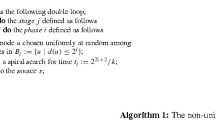Abstract
Efficient graph search is a central issue in many aspects of AI. In most of existing work there is a distinction between the active “searcher”, which both executes the algorithm and holds the memory, and the passive “searched graph”, over which the searcher has no control at all. Large dynamic networks like the Internet, where the nodes are powerful computers and the links have narrow bandwidth and are heavily-loaded, call for a different paradigm, in which most of the burden of computing and memorizing is moved from the searching agent to the nodes of the network. In this paper we suggest a method for searching an undirected, connected graph using the Vertex-Ant-Walk method, where an a(ge)nt walks along the edges of a graph G, occasionally leaving “pheromone” traces at nodes, and using those traces to guide its exploration. We show that the ant can cover the graph within time O(nd), where n is the number of vertices and d the diameter of G. The use of traces achieves a trade-off between random and self-avoiding walks, as it dictates a lower priority for already-visited neighbors. Further properties of the suggested method are: (a) modularity: a group of searching agents, each applying the same protocol, can cooperate on a mission of covering a graph with minimal explicit communication between them; (b) possible convergence to a limit cycle: a Hamiltonian path in G (if one exists) is a possible limit cycle of the process.
Similar content being viewed by others
References
R. Aleliunas, R.M. Karp, R.J. Lipton, L. Lovasz and C. Rakoff, Random walks, universal traversal sequences, and the complexity of maze problems, in: 20th Annual Symposium on Foundations of Computer Science, San Juan, Puerto Rico (October 1979) pp. 218–223.
G. Barnes and U. Feige, Short random walks on graphs, in: Proc. of the 25th ACM STOC (1993).
M. Blum and D. Kozen, On the power of the compass, or, Why mazes are easier to search than graphs, in: Proc. of FOCS' 78 (1978) pp. 132–142.
M. Blum and W.J. Sakoda, On the capability of finite automata in 2-and 3-dimensional space, in: Proc. of FOCS' 77 (1977) pp. 147–161.
A.Z. Broder, A.R. Karlin, P. Raghavan and E. Upfal, Trading space for time in undirected s–t connectivity, SIAM J. Comput. 23(2) (1994) 324–334.
M. Dorigo, V. Maniezzo and A. Colorni, The ant system: Optimization by a colony of cooperating agents, IEEE Trans. on Systems, Man, and Cybernetics – Part B 26 (1996) 29–41.
S. Even, Graph Algorithms (Computer Science Press, Rockville, MD, 1979).
A.S. Fraenkel, Economic traversal of labyrinths, Math. Mag. 43 (1970) 125–130, and a correction in 44 (1971) 12.
S. Gal and E.J. Anderson, Search in a maze, Probab. Engrg. Inform. Sci. 4 (1990) 311–318.
C.V. Goldman and J.S. Rosenschein, Emergent coordination through the use of cooperative state-changing rules, in: Proc. of The National Conference on AI, Seattle, WA (August 1994) pp. 408–413.
J. Hopcroft and R. Tarjan, Efficient algorithms for graph manipulation, Comm. ACM (1973) 372–378.
R.E. Korf, Real-time heuristic search, Artificial Intelligence 42 (1990) 189–211.
S. Koenig and Y. Smirnov, Graph learning with a nearest neighbor approach, in: Proc. of COLT' 96, Desenzano del Garda, Italy (June 28–July 1, 1996).
N. Madras and G. Slade, The Self-Avoiding Walk (Birkhäuser, Basel, 1993).
R. Tarjan, Depth-first search and linear graph algorithms, SIAM J. Comput. 1(2) (1972) 146–160.
G. Tarry, Le problem des labyrinths, Nouvelles Annales de Mathematiques 14 (1895) 187.
S. Thrun, The role of exploration in learning control, in: Handbook for Intelligent Control: Neural, Fuzzy and Adaptive Approaches (Van Nostrand Reinhold, Florence, KY, 1992).
S. Thrun, Efficient Exploration in Reinforcement Learning, Technical Report CMU-CS-92-102, Carnegie-Mellon Univ., Pittsburgh, PA (1992).
I.A. Wagner, M. Lindenbaum and A.M. Bruckstein, Smell as a computational resource – a lesson we can learn from the ant, in: Proc. of ISTCS' 96 (1996) pp. 219–230. Web accessible through: http://www.cs.technion.ac.il/_wagner.
I.A. Wagner, M. Lindenbaum and A.M. Bruckstein, Cooperative covering by ant-robots using evaporating traces, Technical Report CIS-9610, Center for Intelligent Systems, Technion, Haifa (April 1996); to appear in IEEE Trans. Robot. Autom.
Author information
Authors and Affiliations
Rights and permissions
About this article
Cite this article
Wagner, I.A., Lindenbaum, M. & Bruckstein, A.M. Efficiently searching a graph by a smell-oriented vertex process. Annals of Mathematics and Artificial Intelligence 24, 211–223 (1998). https://doi.org/10.1023/A:1018957401093
Issue Date:
DOI: https://doi.org/10.1023/A:1018957401093




